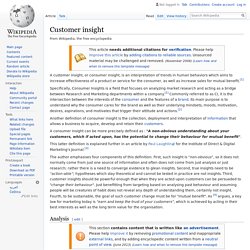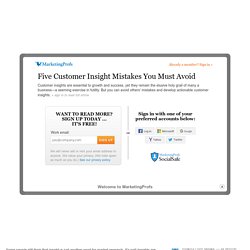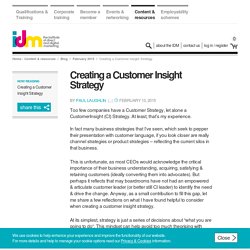

5 Ways to Design Products Customers Love. Executive Summary There are two well-known ways of using design thinking to make better products and services: employ user-designers who represent the customer base, and rely on ethnographic research to get inside users’ heads.

But recent research on architectural firms highlights three other approaches: Temporarily adopt the role of user; immerse oneself in the customer or client’s culture; and use cognitive artifacts in parallel with prototypes to enhance creativity. As a teenager, Mike Pfotenhauer loved to hike, but he hated how uncomfortable he felt carrying the backpacks then on the market. 3 Things Are Holding Back Your Analytics, and Technology Isn’t One of Them. Executive Summary Many firms continue to struggle with business analytics.

This has nothing to do with technology. We’ve found three main obstacles to realizing analytics’ full value: the organization’s structure, culture and approach to problem solving. Structurally, analytics departments can range between two opposite but equally challenging extremes. On the one hand are data science groups that are too independent of the business. Maslow's hierarchy. Customer needs heirarchy. When customers evaluate a product or service, they weigh its perceived value against the asking price. Marketers have generally focused much of their time and energy on managing the price side of that equation, since raising prices can immediately boost profits. But that’s the easy part: Pricing usually consists of managing a relatively small set of numbers, and pricing analytics and tactics are highly evolved.
What consumers truly value, however, can be difficult to pin down and psychologically complicated. How can leadership teams actively manage value or devise ways to deliver more of it, whether functional (saving time, reducing cost) or emotional (reducing anxiety, providing entertainment)? Customer insight - Wikipedia.
A customer insight, or consumer insight, is an interpretation of trends in human behaviors which aims to increase effectiveness of a product or service for the consumer, as well as increase sales for mutual benefit.[1] Specifically, Consumer Insights is a field that focuses on analyzing market research and acting as a bridge between Research and Marketing departments within a company.[1] Commonly referred to as CI, it is the intersection between the interests of the consumer and the features of a brand.

Its main purpose is to understand why the consumer cares for the brand as well as their underlying mindsets, moods, motivation, desires, aspirations, and motivates that trigger their attitude and actions.[2] Another definition of consumer insight is the collection, deployment and interpretation of information that allows a business to acquire, develop and retain their customers. Analysis[edit] New Frontiers in Generating Insights. Five Customer Insight Mistakes to Avoid. With so much information flowing into organizations these days, we are all feeling a little overwhelmed.

What's worse, however, is that customer insights haven't increased at the same rate as data availability. Customer insights are essential to growth and continued success, yet they remain the elusive holy grail of business. Insight psychology. Insight definition. Creating a Customer Insight Strategy. Too few companies have a Customer Strategy, let alone a CustomerInsight (CI) Strategy.

At least, that’s my experience. In fact many business strategies that I’ve seen, which seek to pepper their presentation with customer language, if you look closer are really channel strategies or product strategies – reflecting the current silos in that business. This is unfortunate, as most CEOs would acknowledge the critical importance of their business understanding, acquiring, satisfying & retaining customers (ideally converting them into advocates).
But perhaps it reflects that may boardrooms have not had an empowered & articulate customer leader (or better still CI leader) to identify the need & drive the change. Anyway, as a small contribution to fill this gap, let me share a few reflections on what I have found helpful to consider when creating a customer insight strategy. Developing a Customer Insights Strategy.